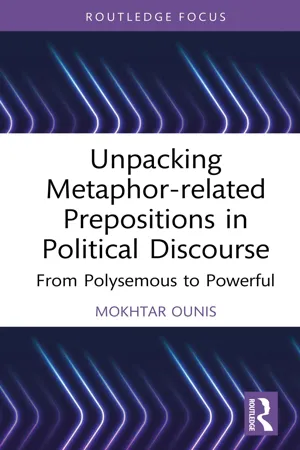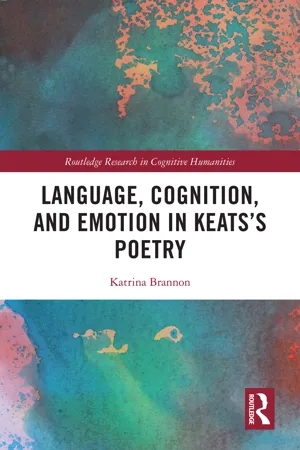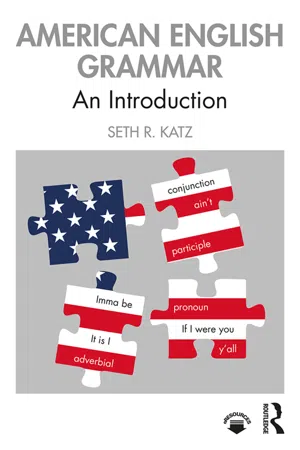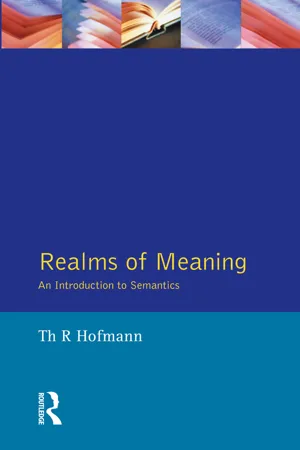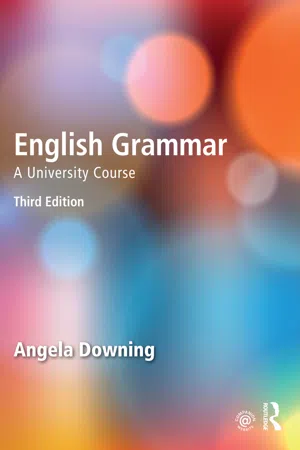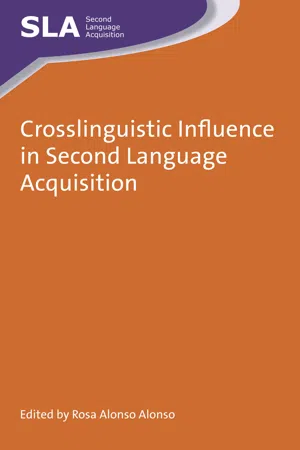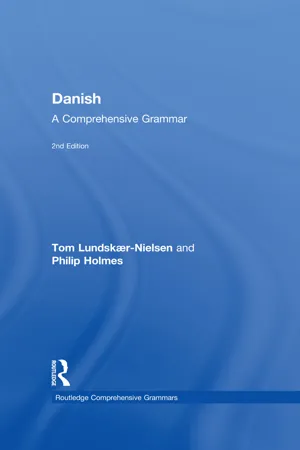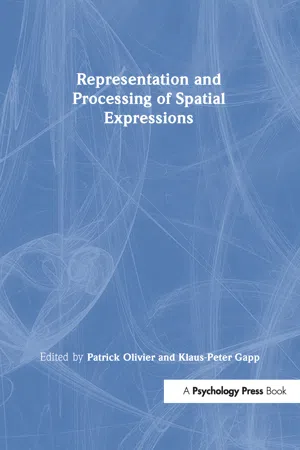Languages & Linguistics
Preposition
A preposition is a word that typically comes before a noun or pronoun and shows the relationship between that noun or pronoun and other words in a sentence. Prepositions often indicate location, direction, time, or the relationship between different elements in a sentence. Common examples of prepositions include "in," "on," "under," "between," and "before."
Written by Perlego with AI-assistance
Related key terms
Related key terms
1 of 4
Related key terms
1 of 3
10 Key excerpts on "Preposition"
- eBook - ePub
Unpacking Metaphor-related Prepositions in Political Discourse
From Polysemous to Powerful
- Mokhtar Ounis(Author)
- 2023(Publication Date)
- Routledge(Publisher)
These dictionary entries consistently highlight two main characteristics of Prepositions: first, their position within a sentence, and second, their function. Prepositions are defined based on their location in relation to other entities within the sentence. Three out of the five definitions incorporate the term “before”, while the fourth definition employs the term “preceding” to emphasize that this positional aspect is intrinsic to the meaning of the Preposition.The etymology of the word “Preposition” underscores its inherent emphasis on position. Its origins trace back to the Latin term praeponere, which combines the prefix prae, denoting “before” or “in front of”, with the verb ponere, meaning “to place” or “to put”. As such, a Preposition signifies an element intended to be positioned before or placed in front of another entity within a sentence.In addition to their positional aspect, Prepositions have another distinct feature: their function. Both dictionaries and grammar textbooks define Prepositions by the function of creating a relation between two entities within a sentence. For example, Quirk et al. (1985 : 657) assert that “a Preposition expresses a relation between two entities, one being that represented by the Prepositional complement, the other by another part of the sentence”. Additionally, the Longman Grammar of Spoken and Written English, a classical grammar reference, defines a Preposition as “mortar which binds [the main building blocks of] texts together” (Biber et al. 1999 : 55).When these two aspects are combined, a Preposition signifies an entity intended to be positioned before another entity while simultaneously establishing a relationship between the preceding entity and the succeeding entity.While these two dimensions distinguish a Preposition from other parts of speech, they alone are insufficient to fully define its precise meaning. The question arises: is the meaning of a Preposition independent or contingent on the relations it establishes, or is it a combination of both? Regarding the first view, it posits that a Preposition possesses a fundamental semantic value that is accompanied by a constellation of interconnected meanings. Alternatively, the second view posits that Prepositions derive their meanings through their semantically related associations and that these meanings can be accurately determined and anticipated via computational means, as explained by Srikumar and Roth (2013 - Katrina Brannon(Author)
- 2022(Publication Date)
- Routledge(Publisher)
Prepositions play an essential, constructive, and linking role in grammar and semantics. In regard to this, Gibbs remarks that “Prepositions seem to be particularly good at pushing their objects around” (1994 : 48). Furthermore, one intrinsic quality of Prepositions in language is their ability to express the notions of space and time, which are very often conceptualized and verbalized metaphorically, as there is an inherent “thematic parallelism between space and time that results in a single set of abstract relations between the two domains [of space and time]” (Gibbs 1994 : 168). Thus, it is logical to see Prepositions as grammatical elements which are fundamentally metaphorical, given the fact that their primary vocation within language is to allow for the expression of processual relationships. This unique quality of Prepositions thus renders them particularly salient in the analysis of conceptual metaphor, particularly within poetic language, as the combination and multiplication of metaphorical expression is central. As R. Gibbs observes, “metaphorical mappings do not occur in isolation from one another” (Gibbs 1994 : 152). This leads to reflection upon the intrinsic metaphoricity of grammatical classes and the ways in which they are capable of rendering conceptually metaphorical concepts more salient metaphorically, by way of the superposing of “higher and lower metaphorical mappings” (Gibbs 1994 : 152). Therefore, Prepositions are key to the full expression of conceptual metaphor: particularly in poetic metaphor, within which the combination of metaphorical mappings is most welcome. Spatial Prepositions, moreover, play a special role in metaphoric expression. 1 In Chapter 4, I delved into the inherent link between conceptual metaphor and force-dynamic expressions. This exploration will continue in the present chapter, as Prepositions hold an important role in causality- eBook - ePub
American English Grammar
An Introduction
- Seth R. Katz(Author)
- 2019(Publication Date)
- Routledge(Publisher)
16Key Points
- Prepositions are function words that convey meaning about locations and movements in space and time, as well as more abstract relations like possession, source, and other literal and metaphoric relationships.
- A Preposition functions as the head of a Prepositional phrase (PP).
- A PP always requires a nominal, most often an NP, as a complement of the Preposition.
- A PP may function as an adjectival or an adverbial.
- An adjectival PP may function as a post-modifier of a noun.
- An adverbial PP may function as a modifier of a verb; a complement of a verb; a modifier of an adjective; or a sentence modifier.
3.4 Exercises: Prepositional Phrases- Made-up sentences:17
- For each sentence,
- Identify each complete PP.
- Identify each Preposition.
- Identify each completNP:PCOMP.
- For each complete PP, try to identify whether it is adjectival or adverbial.
- For each complete PP, try to identify its function (e.g. “MODIFIER OF noun ” or “SENT MOD ”).
Sometimes, there are PPs inside other PP s. Remember
- For each sentence,
- Anand Syea(Author)
- 2023(Publication Date)
- Routledge(Publisher)
8 PrepositionsDOI: 10.4324/9781003458289-88.1 Introduction
This chapter looks at Prepositions in English creoles. Section 8.2 provides some background information on Prepositions in English. Section 8.3 looks at Prepositions in English creoles. Section 8.3.1 focuses on their semantics while Section 8.3.2 looks at their syntax, focusing on Preposition stranding (Section 8.3.2.1 ) and Preposition particles (Section 8.3.2.2 ). Section 8.4 summarizes this chapter and provides a few concluding remarks.8.2 Prepositions in English
Unlike other categories, Prepositions tend to be both lexical and grammatical. Like lexical categories, they express meanings such as location e.g., on, under, by, and so on, or time e.g., after, since, during, and so on, and like grammatical categories, they tend to be smaller in number, more difficult to create, and sometimes have a purely grammatical function, for instance of when used to link an adjective or noun to its complement e.g. afraid of the dark, fond of ice-cream, development of the country, box of matches, threat of war, and so on.Prepositions in English are also unlike other categories in that they do not display any inflectional or derivational morphology. There are, for example, no Prepositions with plural -s e.g. *on-s, or the comparative suffix -er e.g. *under-er, or the participle -ing suffix e.g. *under-ing, and so on, nor Prepositions with derivational suffixes such as -er *beyond-er, -ly *beyond-ly, -ic *beyond-ic, and so on. However, like other categories, they can combine with words from other categories to form compounds such as outlay, overdose, inset, downturn, bylaw, upload, etc. Such compounding is, of course, limited. We can, for instance, have downtrodden but not *uptrodden, outsource but not *insource, implant but not *explant, and so on.Prepositions, like verbs and adjectives, can be transitive or intransitive. Transitive Prepositions are Prepositions such as while, during, and at in that they cannot occur without their complement/object e.g., *The children slept while/during, while Prepositions such as in and after can occur without a complement e.g. They went in; They came after- eBook - ePub
Realms of Meaning
An Introduction to Semantics
- Thomas R. Hofmann(Author)
- 2015(Publication Date)
- Routledge(Publisher)
1 After a Preposition, however, one may well need to stop and think of what nouns or adjectives to say next, and languages that use Prepositions generally allow this by treating them as separatable words.Besides Prepositions and postpositions, the only other common way to show a noun’s function is with ‘case’ as in German above, Latin, Russian and Old English (I:me, he:him are remnants of a complete case system). These are like postpositions except that instead of being behind the whole nominal phrase they are generally suffixed on to the nouns and adjectives in the nominal. Worse, for the foreign learner at least, is that they often have different forms for various genders, as well as for nouns and adjectives. This is not necessary, however. Languages such as Finnish, Eskimo, Hungarian and Turkish have easily learned cases.What is true of Prepositions, then, is roughly true of postpositions and cases, and in fact, cases often double up with Prepositions, just as Prepositions like to can double up with other Prepositions, in e.g., into, on to.Showing locations and limits of eventsPrepositions are also commonly used in referring to things by their locations, as in ‘the book on the table’ or ‘the ride to Banbury Cross’. In English, as in most languages, these same Prepositions are used for showing where something happened. It is easiest to begin here where the Prepositions can combine with elementary verbs like to be, to go to make simple sentences whose meanings can be explored in detail. The table below gives an array of these basic Prepositions.The locative Prepositions [Loc] in the first column are used to describe the location of something by means of some object (at), or as being on its surface (on), or being inside it (in). It is hard to give a meaning to at that is as specific, for it is the ‘unmarked’ term (Chapter 2 - eBook - ePub
- Philip Holmes, Hans-Olav Enger(Authors)
- 2018(Publication Date)
- Routledge(Publisher)
Chapter 7Prepositions
7.1 Introduction7.1.1 Prepositions and their meaning
7.1.1.1
Prepositions describe relations; they often locate one entity (a ‘participant’) relative to another (a ‘landmark’) in space. For example, in Kari ligger i senga, ‘Kari is in bed’, the Preposition i, ‘in’ describes the relation between Kari and senga, ‘the bed’ – she is located relative to the landmark, the bed. In Knut sitter ved det gamle spisebordet, ‘Knut is sitting at the old dining-table’, ved, ‘at’ describes the relation between Knut and det gamle spisebordet.7.1.1.2
However, things are often not so simple. Prepositions can involve temporal relations; locating events in time, as in Kari synger i kveld, ‘Kari is singing tonight’; Beate kommer om åtte dager, ‘Beate will come in eight days’. They can involve more complex abstract relations, as in Arve er glad i Kari, ‘Arve is fond of Kari’; Siri var sint på Unni, ‘Siri was angry with Unni’. In such examples, it may be hard to explain the choice of Prepositions, precisely because the relation is more abstract. Why should Norwegians say glad i, sint på, when the English say ‘fond of’, ‘angry with’? Such questions are difficult; the use of Prepositions is a stumbling block in learning many foreign languages. Still, some Prepositions are extremely frequent, and that means that it is sensible to spend some time on learning some central patterns. Also, Norwegian is a language where location and position matters. This shows not only in the posture verbs (cf. 5.3.4.2(b), 5.8.2), but also in Prepositional usage. There are more compound Prepositions in Norwegian than in English, and they are used more frequently.7.1.2 Morphology
Prepositions are not inflected; they are indeclinable. Prepositions can be morphologically simplex, such as i, ‘in’, på, ‘on’, and the most frequent ones are. They can also be morphologically complex, such as utenfor, ‘outside of’, cf. ute and for, innenfra, ‘from the inside’ cf. inne, ‘in’ and fra, ‘from’, cf. 7.4 below and 11.2.2.16. However, the term Preposition also commonly covers multi-word units such as i stedet for, ‘in place of’, ‘instead of’, på grunn av lit. ‘on grounds of’, ‘because’. While these are not words, but groups of words, they fulfil the same function as single-word Prepositions, and they are dealt with in 7.5 below. Compare Boka blir ferdig om fire uker, ‘The book will be finished in four weeks’ vs. Boka blir ferdig i løpet av fire uker, ‘The book will be finished within four weeks’. Some Prepositional word groups can even be discontinuous, e.g. for … siden, ‘ago’: Det var for tre dager siden - eBook - ePub
English Grammar
A University Course
- Angela Downing(Author)
- 2014(Publication Date)
- Routledge(Publisher)
on ) – in the most basic use. Further uses can then be explained as modifications of the basic image schema, as these mental pictures are perceived and derived from our experience of the world.- Many basic patterns of spatial location are carried over to time relations, such as in the house, in November, in 1492 , and to ordinary metaphorical uses which form part of our daily interaction (in love, in time, in pain ).
59.1 Two Types of Prepositional Meanings
Prepositional meanings can be divided into two broad types:- those in which the choice of Preposition is determined by the verb, noun or adjective preceding it; and
- those in which a Preposition is chosen freely in accordance with the speaker’s intentions.
grammaticised I agree with you; we rely on you; fruit is good for you.lexical We flew/in /into /out of /through /above /below /close to / near/a long way from the clouds .In previous sections we have discussed those Prepositions which are determined by nouns (→ 50.5), adjectives (→ 53.1.3) and verbs (→ 6.3.1; 10.5) (e.g. look after, rely on, put up with). These are all grammaticised; that is to say, in such cases the Preposition does not have its full lexical meaning and is not in open choice with other Prepositions. We noticed that nouns which take Prepositional complements are related to cognate verbs or adjectives that often take the same Prepositional complement, as in the following examples: - Rosa Alonso Alonso(Author)
- 2016(Publication Date)
- Multilingual Matters(Publisher)
The fact that languages divide up and lexicalise spatial configurations and functions in different ways has also been addressed by Tyler and Evans (2003) in their Principled Polysemy Model, which provides a cognitive linguistics account of the various meanings associated with English Prepositions in terms of systematically related polysemy networks. We recognise the value of this powerful model but do not rely on it in the present study because of the nature of our analysis, which focuses on learners’ choice of spatial Prepositions in contexts that reflect fairly prototypical meanings of IN, ON and AT. Our study is nevertheless motivated by a cognitive linguistics perspective that assumes crosslinguistic differences in the ways that speakers of different languages construe spatial configurations. We now turn to the findings of previous research regarding crosslinguistic differences and crosslinguistic influence in the expression of spatial relationships.Crosslinguistic Differences and Crosslinguistic Influence in the Expression of Spatial RelationshipsOne of the misconceptions about spatial Prepositions is that their use is determined solely by the spatial and geometrical configurations of the objects whose relationships they refer to (e.g. apple in a bowl , pen on a table ). Although some Prepositions in some languages (e.g. above in English) might refer relatively straightforwardly to geometrical configurations (but see Tyler & Evans, 2003), others are chosen more on the basis of extra-geometric information, such as location control. Location control refers to the likelihood that if the reference object moves, the located object will move with it (Coventry & Guijarro-Fuentes, 2008). The English Preposition IN is chosen on the basis of both geometric (containment) and extra-geometric (location control) criteria. For example, an apple that is sitting inside a bowl is deemed by English speakers to be in the bowl because the apple is at least partially contained by the bowl and because the apple will move with the bowl if the bowl moves. An apple that is on a table underneath an upside-down bowl, on the other hand, is not in the bowl because, even though the apple is contained by the bowl, the apple will not move when the bowl moves. Studies reviewed by Coventry and Guijarro-Fuentes (2008) show that pre-linguistic infants are sensitive to both geometric and extra-geometric information in preferential looking tasks, and that it is not until infants begin acquiring their native language that their preferences become more language-specific (see also Bowerman & Choi, 2001; McDonough et al- eBook - ePub
- Tom Lundskaer-Nielsen, Philip Holmes(Authors)
- 2015(Publication Date)
- Routledge(Publisher)
på må og få (at random). Other types of meaning will be distinguished under the individual Prepositions.Using Prepositions correctly is one of the most difficult tasks facing learners of a foreign language, and the correct use of Danish Prepositions is no exception. Nevertheless, when comparing Danish and English there are a number of correspondences in the basic meanings of many Prepositions. Generally speaking, it is much easier to predict or ‘guess’ the right Preposition when it has spatial (and, to some extent, temporal) meaning than it is when it has figurative or abstract meaning. This is not surprising since abstract meaning, in particular, is furthest removed from notions of time and space and therefore not subject to the same restrictions of use. This fact is most clearly demonstrated by idiomatic expressions because, by definition, they cannot be broken down into the meanings of their individual parts, but must be understood – and learnt – as whole phrases.It is, of course, impossible to provide an exhaustive treatment of Prepositional usage and meanings within the scope of this chapter, but it is hoped that the following guidelines will be of some use to readers. For more specific exemplification of the use and meanings of individual Prepositions, readers are advised to consult Dansk Sprogbrug, Nudansk Ordbog or a good Danish–English/English–Danish dictionary. The most comprehensive treatment is to be found in the monumental Ordbog over det danske Sprog - Patrick Olivier, Klaus-Peter Gapp(Authors)
- 1998(Publication Date)
- Psychology Press(Publisher)
functional relations between objects. A battery of empirical studies are reviewed that demonstrate that spatial language use is under-determined by geometric relations in the input, and better predicted by functional relations reliant on object-specific knowledge. Given these data, a framework to the encoding and decoding problems is outlined encompassing mental models as an interface between language and the spatial world.1. INTRODUCTIONApproaches to the meaning of spatial Prepositions have largely assumed that spatial Prepositions define a region in which the figure (object to be located) is located with respects to the ground (reference object). For instance, in the sentence, “The pear is in the bowl,” the figure (the pear) is located in the region described by the Prepositional phrase in the bowl, with the spatial relation expressed by in corresponding to something like “contained interior to the reference object.” Thus the content the spatial Preposition contributes to the sentence has to do with the type of spatial relation defining the region, and for those interested in the lexical semantics of spatial terms, the task has been one of identifying the specific regular content(s) associated with such terms (a necessary goal if one is to explain how one produces and understands novel utterances).The problem is that there are a large number of spatial relations that are appropriate for each term. For example, the Preposition in is appropriate to describe the relationship between the various figures and grounds depicted in Fig. 15.1 ; therefore, specifying a single content for in that is appropriate for all these situations is problematic. To complicate matters further, there is also not a one-to-one mapping between spatial relations and Prepositional usage, as the cases in Fig. 15.2 demonstrate. For example, Fig. 15.2(a) is the same spatial relation as Fig. 15.1(a) , butFIG. 15.1. Different spatial relations for which in is appropriate: (a) The coffee is in the cup, (b) The lemon is in the bowl, (c) The flowers are in the vase, (d) The lightbulb is in the socket, (e) The nail is in the board, (f) The page is in the book.FIG. 15.2. Different spatial relations for which in is not appropriate: (a) *The coffee is in the cup, (b) *The lemon is in the bowl, (c) *The ball is in
Index pages curate the most relevant extracts from our library of academic textbooks. They’ve been created using an in-house natural language model (NLM), each adding context and meaning to key research topics.
Explore more topic indexes
Explore more topic indexes
1 of 6
Explore more topic indexes
1 of 4
